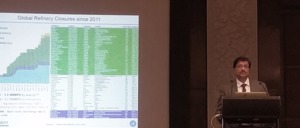IRPC '17: Senior engineer sees "dynamic market" for European diesel imports
By Adrienne Blume, Executive Editor
NEW DELHI, INDIA—During an IRPC 2017 morning session on market analysis, Shailendra Mohite, Senior Engineer—Stakeholder Management at Kuwait Petroleum International, discussed the emerging structural and opportunistic diesel flows of the European market.
China and India are expected to account for more than 45% of global oil product demand growth, while Indonesia, Saudi Arabia, Iran, Iraq and Vietnam will collectively make up 25% of growth. The Asia-Pacific region will see the largest delta increase in demand, Mr. Mohite explained. Meanwhile, global crude oil demand is forecast to grow by around 0.7%/yr.
He then discussed refinery closures since 2011. Worldwide, 5.4 MMbpd of refining capacity is anticipated to be closed by the end of 2017. In Europe alone, 2.2 MMbpd of capacity will be shuttered for economic reasons.
Gasoline/diesel imbalance in transportation sector. With regard to the refined products supply/demand scenario for oil products, "Diesel will dominate, even though the growth rates are less than the gasoline demand growth rate," Mr. Mohite said. "Gasoline is expected to continue to have a premium of at least $2–$4 over diesel."
Europe is expected to import more diesel from the Middle East, North America and Russia, while Asia's diesel/gas oil surplus will be eroded by demand growth. Trade flows will continue to be dominated by Russia and North America, and abundant trade opportunities will continue to emerge in the Asia-Pacific market. "It's highly competitive," Mr. Mohite asserted. "Everyone is targeting the same market."
The region's diesel deficit is anticipated to double from 0.9 MMbpd in 2015 to 2 MMbpd by 2022. The present diesel-to-gasoline demand ratio is 2.49, mainly as a result of diesel tax incentives that have significantly changed EU road fuel demand.
"Russia continues to dominate the [diesel] export market [to Europe], followed by the US," Mr. Mohite said. "Shale oil and cheap energy in the US may help the country to compete in the market. The US will become a net exporter of petroleum products in the near future."
"Growth in transportation sector demand will be around 25% from 2015 to 2040; that's a long way to go," Mr. Mohite noted. "But overall, there will be a reduction in the number of light-duty vehicles, partially as a result of energy efficiency [improvements] … Diesel will see a squeeze on its consumption by light-duty vehicles."
Electric vehicles, on the other hand, will displace 6% of global oil demand by 2035. "Overall, 6% seems to be very optimistic," Mr. Mohite opined. "This is at least a 100% increase in the number of electric vehicles, which is a very high number."
Europe's future refining challenges. With regard to the bunker fuel outlook to 2030, Mr. Mohite noted, "Because of the uncertainty of the [marine fuels and emissions regulations] compliance, we don't know how far Europe will have to go to meet these changes. However, once the market is stabilized, over the medium-term, refiners will make a little bit of money. But who will invest, and when, remains uncertain."
In summary, Mr. Mohite noted that Europe's refining situation is challenged by several factors. Approximately 1.6 MMbpd of capacity will be mothballed by 2019, partly as a result of low petrochemicals integration and inadequate specialty fuels and chemicals production.
Logistics constraints, high-cost operations (particularly for simple and small refineries), and narrow export windows also pose challenges for European refiners.
The difficult European refining scenario will open new avenues for diesel export markets from the Middle East and Asia. Diesel imports are expected to double from 12% of European demand in 2016 to 25% of demand in 2022.
"More opportunities will emerge for Europe to become a bigger market for exports, mainly from the Middle East and Asia," Mr. Mohite said. "However, this depends on pricing and the current demand level, and how soon we see oil prices going up."
Beyond 2020, a number of factors will impact European diesel flows:
- IMO regulations starting in 2020
- Diesel fuel switching for heating and power
- Climate change initiatives springing from the Paris Climate Change Agreement
- Ultra-low-emissions zones (ULEZ) policies that will require nitrogen oxide and particulate emissions levels equivalent to those from gasoline vehicles
- Ban on diesel vehicles in Paris, Madrid, Athens and Mexico City from 2025 onward
- Ban on diesel engine manufacturing and sales in Germany from 2030 onward.
"All of these factors influencing diesel will continue to make it a very dynamic market, and a dynamic one to capture," Mr. Mohite said in closing.
IRPC 2017 is taking place at the Taj Palace in New Delhi from April 18–20.








Comments